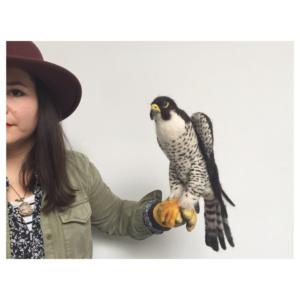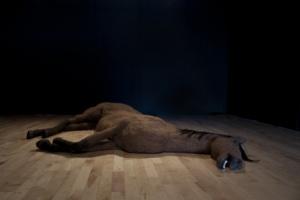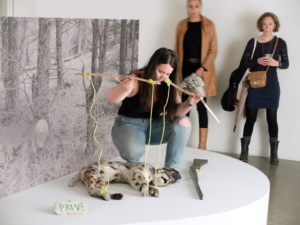HOLD FAST artist in residence: Vicky Sabourin

Vicky is currently using Eastern Edge Gallery as her studio. She is busy collecting pebbles, felting and making art. Drop in to have a chat and see what she is up to! Here is what Vicky has to say about her residency plans:
Warmblood & Becoming Invisible
For the month of July, Eastern Edge Gallery becomes my open studio where two body of works are displayed side by side. First Warmblood, where a life size felted horse lies on the ground next to a photograph of a hole in the ground. Although the piece is completed, it is presented in the in between moment, lying flat and empty on the ground.
The other body of work is Becoming Invisible and it is currently in process. This multi chapter installation addresses my pilfering compulsions, the universe of falconry and my fear of becoming invisible.

Becoming Invisible
Many stories involve the disappearance of a persona in folklore and fairy tales. There are accounts of individuals or groups who mysteriously disappear in the wilderness – forest, mountain, at sea – and others who deliberately become invisible by handling an enchanted object like a ring, a potion or a magical cloak. These two opposing narratives dwell on our fears and fantasies of becoming invisible.
The pleasure that could provide the status of the invisible voyeur never surpassed the terrifying idea of finding myself forever without body or presence; a disembodied and ghostly gaze. This aversion emerges from a deep anxiety – the fear of disappearing. It was during my teenage years that I started to have recurrent dreams where I was transformed into a specter, incapable to communicate with people who surrounded me.
While reading on falconry, my reflections and fears about my own presence reemerged. Becoming invisible is a common strategy used by animals in the wilderness. Falcons are not social animals like dogs and horses. They can never be tamed and they only get used to the human presence. Every time a falcon flies from the hunter’s glove it might never return. For the bird to get accustomed to the falconer’s presence, the human has to try to become invisible. The human presence stinks of death; it is the most terrifying threat for a wild animal. The anthropologist Ranewillerslev explained that Yukaghir hunters believe that “human and animals can turn into each other by temporarily taking on one another’s bodies. (…) These transformations are very dangerous, because they can make you lose sight of your ‘original species identity and undergo an invisible metamorphosis.’”
The notions of presence are at the heart of performative qualities. While visiting the MoMA to see “The Artist is Present” in 2010, I sat in front of Marina Abramovic, the contemporary art guru. My first reaction was that of disappointment. Once seated in front of her, I found that her presence was weak, feeble, far from the energy of the shaman or great warrior that I had constructed through studying her work. Despite all of the media visibility, once in front of Abramovic, she seemed to blend and turn into a mirror that reflected my own image. How could she be so visible and invisible at the same time? This encounter stimulated a reflection about the performer’s presence. Can we qualify a presence such as being good or bad? What makes a good presence? A strong presence, deeply rooted in the present and in the moment? A visible and electrifying presence? According to this logic, a weak, tenuous, fugitive, discreet, invisible presence would be bad.
“Becoming Invisible” confronts my own anxiety as I try to disappear. Immersing myself in the universe of Falconry I will determine tactics that will allow me to become invisible. Questions related to becoming invisible raises other painful issues: it confronts us once more to our own mortality, it carries the political weight of all of the missing and disappearing women and children and it echoes to the ecological disaster of the extinction of some flora and fauna species. By “Becoming Invisible” I confront my own ideas about the bad performative presence and my anxiety of disappearing. Can I find strength in my weakness?
Smuggler
Exploring a new landscape has increased my desire to collect and extract elements from the forest and seashore. This childish behavior seems to be harmless. The specimens I collected were abundant, ordinary and I wasn’t crossing an international border (although it felt like it). The problem worsened when I did a residency at the Banff Center for the Arts and Creativity. I had planned to create a diorama in my studio with a combination of handmade and found elements. I thought there was no harm in collecting rocks and branches around the center. No such things are allowed in a National Park. Even the dead moths that littered the studio floors and corridors were out of reached. Better for them to end up in the landfield than in an art piece. It all felt WRONG. The rule seemed abusive, said the pilferer. It didn’t deter me from collecting the moths, rocks and branches!
Vicky Sabourin is a Montreal based artist. She completed her MFA at Concordia University. Her work has been shown in galleries, artist run centers and museums in Canada, the United States and Europe. Les Curiositiés presented at the Musée National des Beaux-Arts du Québec is one her most recent solo exhibition. In 2017, she exhibited Lac Caché (The Hidden Lake) at the Quebec City Contemporary Art Biennial. Part of that work was produced at the Banff Center for the Arts and Creativity during a 2016 summer residency. Sabourin is a Canada and Québec Art Council recipient.

